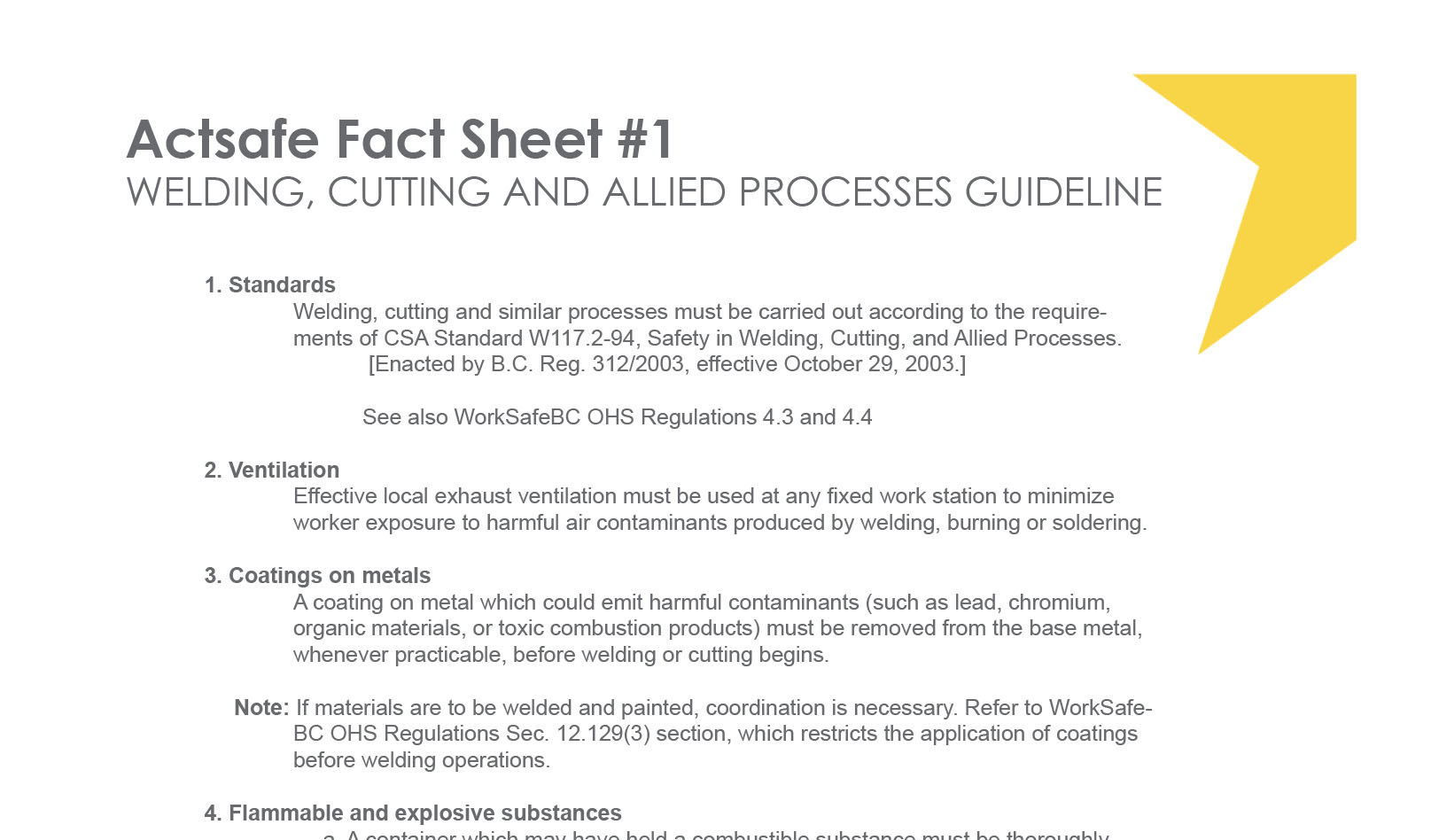- Standards – Welding, cutting and similar processes must be carried out according to the requirements of CSA Standard W117.2-94, Safety in Welding, Cutting, and Allied Processes. [Enacted by B.C. Reg. 312/2003, effective October 29, 2003.] See also WorkSafeBC OHS Regulations 4.3 and 4.4
- Ventilation – Effective local exhaust ventilation must be used at any fixed work station to minimize worker exposure to harmful air contaminants produced by welding, burning or soldering.
- Coatings on metals – A coating on metal which could emit harmful contaminants (such as lead, chromium, organic materials, or toxic combustion products) must be removed from the base metal, whenever practicable, before welding or cutting begins. Note: If materials are to be welded and painted, coordination is necessary. Refer to WorkSafe- BC OHS Regulations Sec. 12.129(3) section, which restricts the application of coatings before welding operations.
- Flammable and explosive substances
- A container which may have held a combustible substance must be thoroughly cleaned before any welding or burning operation is carried out on the container.
- Burning, welding or other hot work must not be done on any vessel, tank, pipe or structure, or in any place where the presence of a flammable or explosive substance is likely until
- tests have been made by a qualified person to ensure the work may be safely performed, and
- suitable safe work procedures have been adopted, including additional tests made at intervals that will ensure the continuing safety of the workers.
- Silver solder – Silver solder containing cadmium must not be used without prior written approval from the Board.
- Correct equipment – Welding equipment, including regulators, automatic reducing valves and hoses, must be used only for the gas for which it is designed.
- Equipment inspection – Before using gas welding or burning equipment, the operator must ensure that the equipment is free from defects, leaks, oil and grease.
- Flashback prevention – Suitable safety devices to prevent reverse gas flow and to arrest a flashback must be installed on each hose in an oxyfuel system, between the torch and the regulator. (See WorkSafeBC OHS Regulations 4.3)
- Receptacles for stubs – Receptacles for electrode stubs must be provided and used.
- Radiation protection
- Arc welding must not be carried out unless workers who may be exposed to radiation from the arc flash are protected by adequate screens, curtains or partitions or wear suitable eye protection.
- A screen, curtain or partition near an arc welding operation must be made of or be treated with a flame resistant material or coating, and must have a non-reflective surface finish. Note: 12m (40ft) is the recommended minimum distance from which an electric welding arc should be seen by the unprotected eye.
- Protective clothing and equipment – A worker involved in welding or burning operations must wear:
- flame resistant work clothing,
- gauntlet gloves of leather or other suitable material and arm protection,
- an apron of leather or other suitable material for heavy work,
- eye and face protection against harmful radiation, particles of molten metal, and while chipping and grinding welds, and
- substantial safety footwear made of leather or other suitable material.Note: Unless specifically manufactured as flame resistant, work clothing made of polyester, acetate, nylon, acrylic or polypropylene fibres, or mixtures of these with wool or cotton do not comply with paragraph (a). Such materials are not flame resistant and will melt while burning, causing deep and extensive burns to the skin. Work clothing made of laminated fabric containing polyurethane sponge should not be worn as it may readily ignite and burn.
Heavier wool or cotton fabrics are preferable to lighter fabrics because they are more difficult to ignite. The fabric should have a smooth tightly woven finish and be maintained in good condition. Follow the manufacturer’s directions for all flame resistant protective apparel to ensure that the flame resistant properties are maintained.
For further information, refer to WorkSafeBC OHS Regulation 12.112



Share Now: